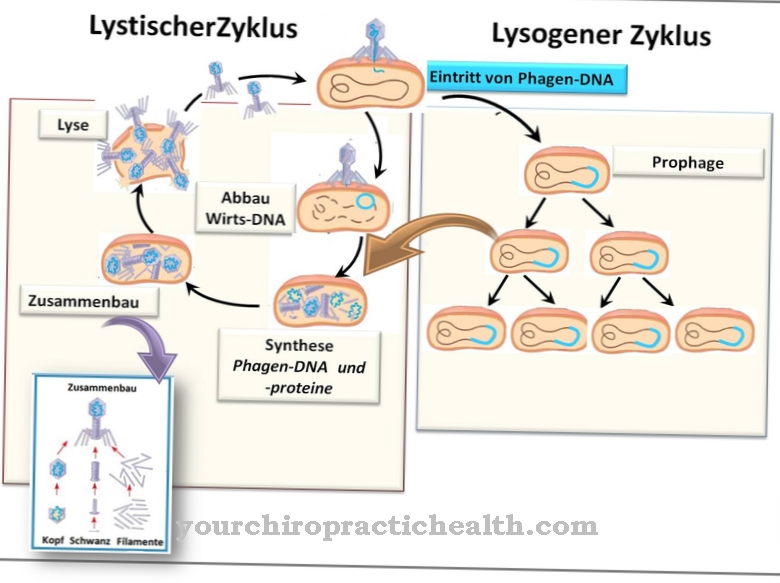Trichophyton is the name for a filamentous fungus genus. This can cause skin and hair disorders.
What is Trichophyton?
Various dermatophytes are grouped together under the name Trichophyton. They are also part of the Arthrodermataceae family. Trichophytes form a genus of filamentous fungi and belong to the Fungi imperfecti (imperfect fungi). These are representatives of higher mushrooms, such as yoke mushrooms, stand mushrooms and tubular mushrooms.
The reproduction of these types of fungi takes place purely vegetatively or through spores that form asexually. In addition, the trichophytes are responsible for the development of trichophytia. This causes fungal diseases on the skin and hair of humans and animals. It is not uncommon for a zoonosis to occur between humans and animals.
Occurrence, Distribution & Properties
The Trichophyton species occur in the soil. But they can also settle in the body of humans and animals. In addition to zoophilic trichophytes, there are also anthropophilic and geophilic species. While there are some species around the world, others only thrive in certain regions. This includes, for example, Trichophyton concentricum. This mushroom lives exclusively in Central America, the Pacific Islands and Southeast Asia.
Together with the trichophytes, two other genera are able to trigger dermatophytes. These are the epidermophytes and the microsporum. All three types belong to the thread fungi and get the energy for their growth from the breakdown of carbohydrates and keratin, which is done by the enzyme keratinase. The three types of fungus can be differentiated through morphological differences.
There are 26 species of Trichophyton known to science. These include, above all, Trichophyton mentagrophytes, which affects cats, dogs and rodents as well as humans, Trichophyton rubrum, which can affect horses and cattle in addition to humans, and Trichophyton verrucosum. This Trichophyton species is restricted to cattle and horses. The most common Trichophyton species also include Trichophyton tonsurans, Trichophyton schoenleinii and Trichophyton violaceum.
The colonies of the trichophytes have a cotton-like and velvety surface with a white-brown color. Your taplin agar changes color from orange-yellow to red. With the help of a microscope, rounded club-shaped macroconidia can be seen on the mushrooms. However, not every Trichophyton species is endowed with these macroconidia. If they are present, they have one to twelve septa, which have a thin, smooth cell wall. As a rule, they are single or in clusters. They can be cylindrical, club spindle-shaped or elongated and pointed. The size of the macroconidia is very different.
Microconidia are more common than macroconidia. They are stalked or sessile and have the shape of a club or pear. They arise on the sides of the hypha either in grape-like clusters or individually. Some can only sporulate on appropriate media.
The most important nutritional component of the trichophytes is keratin, which is found in the hair and nails of humans and animals. The trichophytes live parasitically, which is why they are counted among the dermatophytes. While Trichophyton rubrum and Trichophyton tonsurans parasitically colonize human hair, nails and skin, Trichophyton verrucosum and Trichophyton equinum thrive on the skin and fur of mammals. Trichophytes such as Trichophyton ajelloi, whose habitat is formed by the soil or fallen pelts, are rarely parasitic.
The transmission of Trichophyton fungi can take place directly from person to person. Infection with the fungus is also possible through contact with infected animals or through contaminated soil. This affects the human skin, hair and nails.
You can find your medication here
➔ Medicines against skin redness and eczemaIllnesses & ailments
The trichophytes are the main cause of fungal infections of hair, skin and nails. The virulence factors of the fungal species are formed by several enzymes such as elastase and proteinase. In addition to being infected by other people or animals, the person affected can also contract the fungus through objects such as carpets or clothes, as well as dust or moisture in swimming pools or showers.
The genus Trichophyton has the property of causing dermatomycoses. This primarily includes skin mycosis (tinea coporis). The affected people suffer from scaly, reddish efflorescences. These start in the middle of the body and then spread to the outer areas. The main cause of tinea corporis is Trichophyton mentagrophytes.
Nail mycosis (tinea unguium) is also caused by the trichophytes. In addition to Trichophyton mentagrophytes, Trichophyton rubrum is also one of the most common triggers. Furthermore, it can lead to hair mycosis (tinea capitis), for which Trichophyton tonsurans is mostly responsible. A hair mycosis is noticeable through brittle hair. A sub-form of hair mycosis is tinea barbae, in which the whiskers on the face are attacked by trichophytes. Trichophyton mentagrophytes and Trichophyton rubrum are responsible for this.
If a fungal infection occurs through trichophytes as a result of transmission by an animal, the disease usually takes a more severe course than if it were infected from person to person. A bacterial superinfection threatens as a possible complication.
In order to make a diagnosis and to prove the respective pathogen, the examining doctor removes some flaking scales from the edge of the damaged skin regions. Nail parts or hair of the patient can also serve as examination material. The detection of the trichophytes is done by creating a fungal culture and a microscopic examination.
Trichophyton can be effectively combated with the use of antifungal agents such as ketoconazole, itraconazole, fluconazole, amorolfine, naftifine, terbinafine or clotrimazole.

.jpg)






.jpg)



















